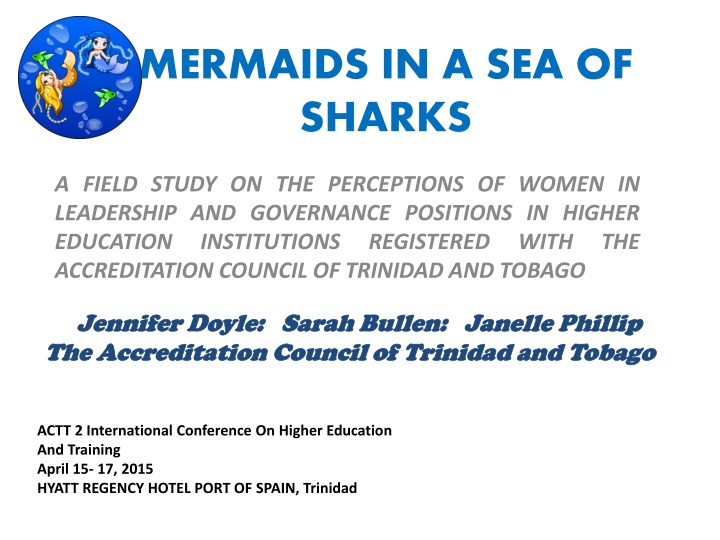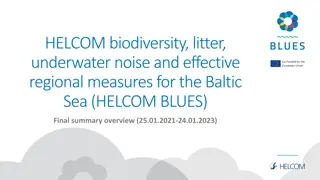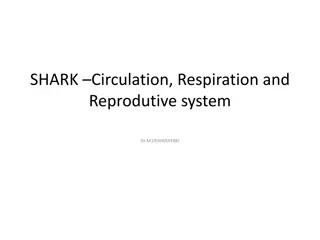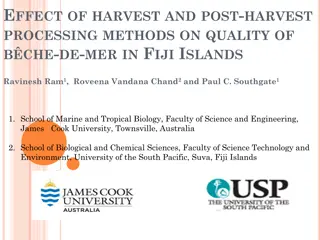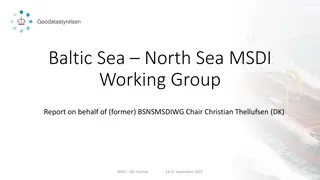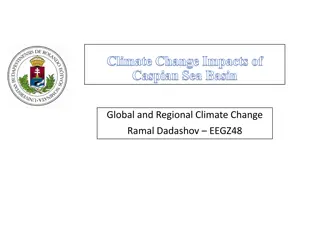MERMAIDS IN A SEA OF SHARKS
A field study examining the perceptions of women in leadership roles within higher education institutions, accredited by the Accreditation Council of Trinidad and Tobago. The study, conducted by Jennifer Doyle, Sarah Bullen, and Janelle Phillip, was presented at the ACTT 2nd International Conference on Higher Education and Training. The conference took place at the Hyatt Regency Hotel in Port of Spain, Trinidad from April 15-17, 2015.
Download Presentation

Please find below an Image/Link to download the presentation.
The content on the website is provided AS IS for your information and personal use only. It may not be sold, licensed, or shared on other websites without obtaining consent from the author.If you encounter any issues during the download, it is possible that the publisher has removed the file from their server.
You are allowed to download the files provided on this website for personal or commercial use, subject to the condition that they are used lawfully. All files are the property of their respective owners.
The content on the website is provided AS IS for your information and personal use only. It may not be sold, licensed, or shared on other websites without obtaining consent from the author.
E N D
Presentation Transcript
MERMAIDS IN A SEA OF SHARKS A FIELD STUDY ON THE PERCEPTIONS OF WOMEN IN LEADERSHIP AND GOVERNANCE POSITIONS IN HIGHER EDUCATION INSTITUTIONS ACCREDITATION COUNCIL OF TRINIDAD AND TOBAGO REGISTERED WITH THE Jennifer Doyle: Sarah Jennifer Doyle: Sarah Bullen The Accreditation Council of Trinidad and Tobago The Accreditation Council of Trinidad and Tobago Bullen: Janelle Phillip : Janelle Phillip ACTT 2 International Conference On Higher Education And Training April 15- 17, 2015 HYATT REGENCY HOTEL PORT OF SPAIN, Trinidad
THE FIELD STUDY Focused on obtaining the views of women who lead our higher education institutions on issues of leadership and governance Purpose of the study : to engage our women leaders in Reflective Practice that promote continuous learning & improvement guide our women leaders in exploring the relationship between governance and quality assurance at their institutions
OVERVIEW What prompted the study Global Factors world focus on governance structures as integral to quality : leadership as a key driver: internationalization: massification: economic research lit. on women administrators in HEI increases:
National survey found women hold only 23% of higher education institution presidencies (American Council on Education, 2007). However, women now earn 58% of all bachelor s degrees and 45% of all doctorates (U.S. Department of Education, 2005). These findings suggest something may be interfering with the pool of capable women moving through the pipeline to attain higher education administrative positions. Lepkowski, C. C. (2009). Gender and the career aspirations, professional assets, and personal variables of higher education administrators. Advancing Women in Leadership Journal, 27(5).
LOCAL ENVIRONMENT Expansion in higher ed. institutions esp. private institutions Statistics at primary & secondary levels leadership Statistics of attendance at tertiary level institutions ACTT records of women in leadership positions These findings suggest something may be interfering with the pool of capable women moving through the pipeline to attain higher education administrative positions.
So!!!! Whats in a name? Melodramatic appeal Visualization Symbolism
KEY QUESTIONS Research questions which guided the study were: What are the perceptions of our women leaders on governance arrangements and practices in their institutions? What perceptions do our women leaders hold of their leadership at their institutions? What can be done to attract women into leadership and governance positions?
METHODOLOGY Research Design- Descriptive research approach Target Group- Purposive Sampling -21 female led institutions Duration of study - 3 week period Data Collection Procedures- Questionnaires: (2) telephone interviews (2): ACTT Records Content- demographic: Leadership: Governance Pilot of questionnaires
METHODOLOGY Preparation of cover letter and issuing of questionnaires by email deadline date for return Follow up phone calls Response rate: 81% = 17 of 21 institutions Data Analysis Techniques - mainly descriptive
DEFINITION OF TERMS DEFINITION OF TERMS Governance Arrangements and structures that are in place to fulfill the mission statement of the institution Field Study focused on Board of Directors
A glass ceiling is defined as those artificial barriers based on attitudinal or organizational biases that prevent qualified individuals from advancing upward in their organizations into managerial-level positions (U.S. Department of Labor, 1991) (pg 1 Women s Access to Higher Education Leadership: Cultural and Structural Barriers Julia Ballenger, Professor, Stephen F. Austin State University)
FINDINGS FINDINGS
BIO DATA ON WOMEN LEADERS Item # % AGE 30-50 years > 50 MARITAL STATUS Single 06 11 35 65 Age 03 18 Married 10 59 other 04 23 CHILDREN YES NO 13 04 76 24
Institution Type Tec. Vocational Religious Academic Other Status # 07 01 08 01 % 41 06 47 06 State Private Size <50 51-100 > 100 01 16 06 94 06 04 07 35 24 41
GOVERNANCE GOVERNANCE What are the perceptions of our women leaders on governance arrangements and practices at their institutions?
FOUR AREAS OF GOVERNANCE Strategic Planning. Financial issues P GOVERNANCEP P P Monitoring & Risk Management Effectiveness in carrying out responsibilities 16 I
GOVERNANCE GOVERNANCE 100% of participants believed that good governance operated at their institutions Legitimized governance through Bye Laws: statutes Institutions did not have student reps. on Board of Directors
CHAIRPERSONS OF BOARDS 0 0 7 Male female 10 Dispels the belief by Hough & Holland (2011) that male members still dominate Board positions . but conforms to the big picture of ACTT Records
BOARD DIVERSITY 0 0 76 male female 102
BOARD MEETINGS BOARD MEETINGS FREQUENCY OF MEETINGS # OF INSTITUTIONS Less than twice per year 01 Twice per year 02 More than twice per year 14 As the need arises 05 Reference:
SUMMARY OF PERSPECTIVES Members of your Board ITEM Yes No Needs Improvement Have a clear vision and strategic direction 16 01 More than 3 members are also on Mgt team 11 07 Possess the competencies to carry out tasks effectively 15 02 Possess the knowledge to manage risk and changes in the environment 14 03 Interfere with daily mgt operations 01 16
Statement Yes No Needs Improvement Engage in stringent financial practices Engage in effective monitoring Ensure that a robust assessment is done Ensure that the institution operates effectively and efficiently Hold the mgt team accountable for performance 14 03 15 02 14 03 15 02 17 00
LEADERSHIP Self Efficacy Experiences Leadership Style Values and attitudes Leadership of women at HEIs assessed based on a 4- pronged approach
LEADERSHIP Table 1: Self Efficacy on female leaders at HEIs Strongly Agree 82% 82% Agree Confidence as a leader Confidence in dealing with unexpected events Problem solving Consistent Achievement of Goals 18% 18% 82% 82% 53% 18% 18% 47%
LEADERSHIP LEADERSHIP The experiences of women leaders at HEIs: Majority enjoyed being the head of the institution (88% strongly agreed) This can be due to: Little discrimination by male leaders from other HEIs (only 6% strongly agreed that men leaders acted in a discriminatory manner) No challenges from males in the organisation (52% strongly agreed)
Acceptance by women leaders from other HEIs (47% strongly agreed and 17% agreed) Assurance that women in leadership positions at HEIs will assist (47% strongly agreed
LEADERSHIP Table 2: Leadership styles of women at HEIs Trinidad and Tobago Strongly Agree Agree Neutral Disagree Strongly Disagree Directive 0 2 3 6 6 Supportive 7 9 1 0 0 Participative 14 3 0 0 0 Delegative 12 5 0 0 0 Inspirational 10 6 1 0 0 Leadership styles based on Van Wart s classification (2008)
LEADERSHIP LEADERSHIP Values and attitudes female leaders in HEIs in T&T hold: Motivates employees through rewards and incentives Have a clear sense of purpose and achievement Always seek the welfare of employees Adheres to ethical practices 75% Strongly Agree 75% Strongly Agree 31% Strongly Agree 87% Strongly Agree 25% Agree 25% Agree 44% Agree 13% Agree 19% Neutral 6% Disagree
Thus some women demonstrated Transactional Type of Leadership Ref: Hough & Holland (2011) Leadership Styles of Effective Female Administrators I Higher Education, American International Journal of Contemporary Research Vol. 1#2
SOCIAL AND CULTURAL BARRIERS Cultural barriers inhibit women from leadership Equal Opportunity policies have helped women assume leadership positions Women did not agree that other women did not assist them Ref: Hough & Holland (2011) Leadership Styles of Effective Female Administrators I Higher Education, American International Journal of Contemporary Research Vol. 1#2
LEADERSHIP LEADERSHIP Despite the great experiences as leaders, women at HEIs in T&T: 59% 12% Face major challenges in managing people Challenges from males within the organisation 6% Discrimination from male leaders in other HEIs
CHALLENGES CHALLENGES Adherence by staff to set policies Loneliness of institutional environment People management/ ensuring harmonious work and study practices across cultural backdrop Culture/ attitude (ability and willingness to accept change Time Management
INCREASING OUR WOMEN LEADERS Special training programmes on leadership for women Using women leaders as role models Changing the mindset of women Changing the mindset of men and the general public
Culturing of the young minds Education Bring awareness of women who hold leadership positions education on promoting capabilities of women Provide avenues for women to start their own business Mentoring programmes Professional Development Programmes for women
Attractive remuneration Provide support for women with families Ensuring a level playing field Transparency in recruitment and selection
CONCLUSION Women were generally satisfied with their Board s governance arrangements The glass ceiling appears to be a form of discrimination affecting women s access to leadership status in higher education Women perceived themselves to be Transformational Leaders - confident, organized, understanding their goals, inspiring and motivating employees and developing the skills of their employees Ref: Eagly A; Women as Leaders: Leadership Styles Versus Leaders Values and Attitudes: Harvard Business School
Women possessed communal attributes as concern for the welfare of people, nurturant, accepting the directions of others, supporting others Ref: Eagly et al, 2001 The Leadership Styles of Women and Men : Journal of Social Issues 6.22/01
Five Minds for the Future Disciplined Ethical Synthesizing Creating Respectful Gardner, 2009 2025-03-01 38
In quoting Ian Alleyne- famous saying.... The Hunt is on for quality governance and Leadership within our institutions
